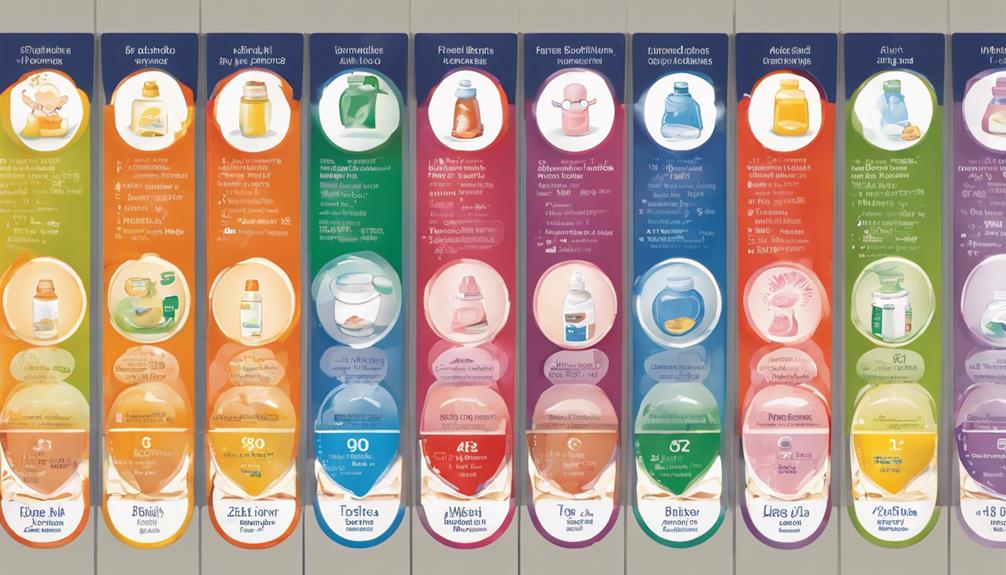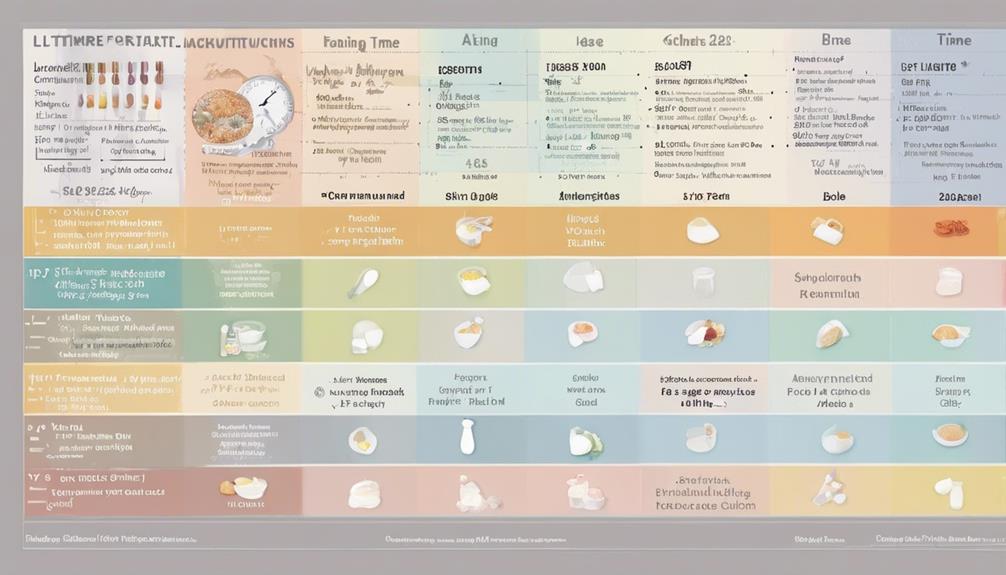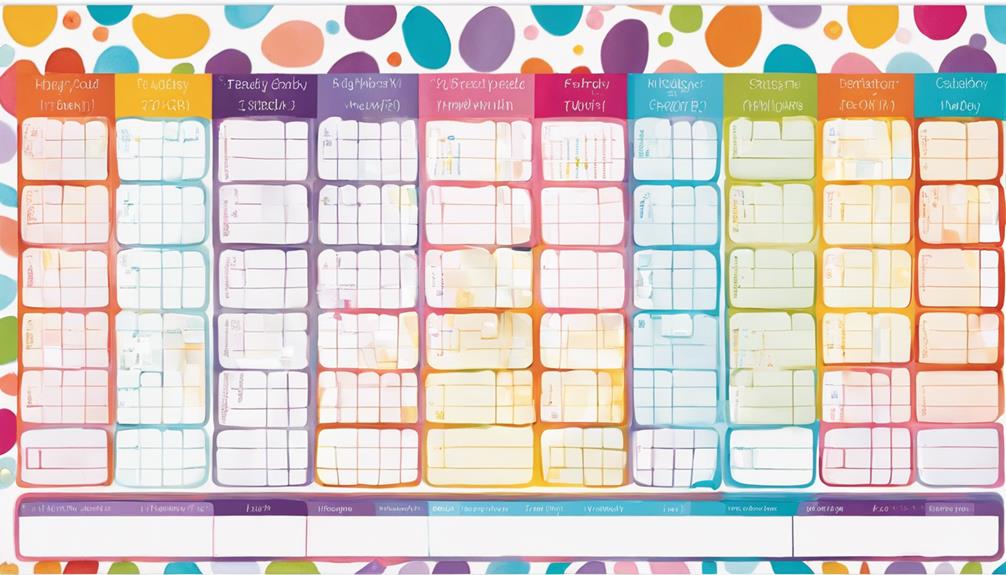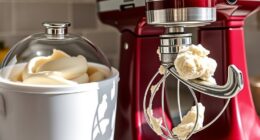In our exploration of the Comprehensive Guide to Bobbie Formula Feeding Charts, we uncover a wealth of information tailored to the nutritional needs of a 3-month-old baby. Offering age-appropriate feeding recommendations, tips on bottle feeding, and details on transitioning to Bobbie Formula, this guide serves as a valuable resource for parents navigating the intricate world of feeding infants.
But what sets this guide apart? Stay tuned to discover how it addresses common feeding issues and provides practical solutions for a seamless feeding journey.
Key Takeaways
- Follow age-specific feeding guidelines for healthy growth.
- Ensure proper bottle feeding techniques for comfort and digestion.
- Gradually transition to Bobbie Formula for familiar taste and essential nutrients.
- Troubleshoot feeding issues promptly, consulting healthcare providers as needed.
Formula Feeding Chart Overview
In the Bobbie formula feeding chart overview, parents can find precise recommendations for feeding volumes tailored to their infant's age and weight. This detailed guide assists caregivers in establishing a structured feeding schedule that aligns with the baby's needs. By following the chart, parents can make sure their little ones receive complete nutrition and hydration throughout the day. It serves as a valuable tool for monitoring the baby's daily feeding intake, promoting healthy growth and development.
Furthermore, the Bobbie formula feeding chart offers a thorough resource for parents to track their baby's feeding patterns accurately. This not only aids in establishing a consistent feeding routine but also helps in identifying any deviations that may require adjustment. With the guidance provided in the chart, caregivers can feel more confident in meeting their baby's nutritional requirements and fostering a healthy feeding relationship.
Age-Appropriate Feeding Guidelines

Moving on to the age-appropriate feeding guidelines, it's important to understand the recommended daily intake for infants at different stages of development. For instance, a 3-month-old baby may consume 24-32 ounces of breastmilk or formula daily, divided into 6-8 feedings. It's key to pay attention to your baby's cues for hunger, such as rooting or sucking on fists, to make sure they're getting adequate nourishment.
When your baby is still feeding through a tube, it's important to follow the guidelines provided by healthcare professionals to meet their specific needs. Bobbie Formula is designed to provide complete nutrition, meeting both European and U.S. standards, supporting your baby's growth and development. Remember, feeding quantities may need to be adjusted based on your baby's appetite variations, so consulting with a pediatrician for any concerns is always a good idea.
While the feeding chart offers volume guidelines, every baby is different, so adapt the feeding schedule to best suit your baby's individual needs.
Bottle Feeding Tips and Techniques
When bottle feeding your baby, selecting the appropriate bottle is crucial to guarantee a comfortable and successful feeding experience. Here are some tips and techniques to make sure smooth bottle feeding sessions:
- Choose the Right Bottle: Opt for bottles designed to mimic the natural flow and feel of breastfeeding. This can help prevent nipple confusion and guarantee a smooth shift between breast milk and formula.
- Match Nipple Flow Rates: Select nipples with flow rates that match your baby's feeding pace. This guarantees they can comfortably drink milk without getting overwhelmed or frustrated during feeding.
- Positioning Matters: Hold the bottle at an angle that allows the milk to completely fill the nipple, preventing air intake. Position the baby in a way that keeps their head slightly elevated to aid digestion and prevent discomfort in their stomach.
- Hygiene is Key: Regularly clean and sterilize bottles to maintain hygiene standards and prevent any potential infections or illnesses in your little one. Proper cleaning also guarantees the longevity of the bottle for continued safe use.
Transitioning to Bobbie Formula

Shifting infants to Bobbie formula involves gradually introducing this nutritionally rich option into their feeding routine to guarantee a smooth adjustment period. Bobbie formula is a suitable choice for switching from breastmilk to formula feeding, providing complete nutrition tailored to meet infants' specific needs.
Modeled after breast milk, Bobbie formula offers a familiar taste and composition, easing the change process. This formula is fortified with essential nutrients, including water-extracted DHA important for brain development in infants.
By incorporating Bobbie formula into your baby's feeding routine, you make sure they receive the necessary nutrients for best growth and development. With proper guidance and support, switching to Bobbie formula can be a seamless experience, promoting your baby's overall health and well-being.
Trusting in the benefits of Bobbie formula can give you peace of mind knowing that your little one is receiving quality nutrition to support their growth and brain development.
Troubleshooting Common Feeding Issues
To address common feeding issues like spitting up, gas, or fussiness during feeds, it's important to troubleshoot potential causes and make necessary adjustments. When feeding your baby, try Bobbie formula and consider the following tips:
- Verify the latch: Verify your baby is latching correctly to prevent excess air intake, which can lead to gas and fussiness.
- Avoid overfeeding: Pay attention to your baby's cues to prevent overfeeding, which can cause spitting up and discomfort.
- Watch for nipple confusion: If you're alternating between breastfeeding and bottle-feeding, be mindful of nipple confusion, which can lead to feeding issues.
- Consult a healthcare provider: If feeding issues persist beyond the first months or worsen, please consult a healthcare provider for personalized guidance and support.
Frequently Asked Questions
How Many Scoops of Bobbie Formula for 6 Oz?
We typically add 6 scoops of Bobbie formula powder to a 6 oz bottle. Each scoop is designed to measure out accurately for proper mixing, ensuring your baby gets the right nutrition.
Keeping to the recommended ratio of 1 scoop per 1 oz of water is vital for maintaining consistency. Accurately measuring the formula guarantees your little one receives the necessary nutrients at each feeding.
How Much Formula Does 1 Can of Bobbie Make?
We can't emphasize enough how important it's to understand how much formula one can of Bobbie makes. This knowledge helps us plan and guarantee we've enough supply for our baby's needs.
Following the mixing instructions makes sure we get the correct number of servings. It's all about being prepared and consistent in meeting our little one's feeding requirements.
Is Bobbie Formula Closest to Breastmilk?
Yes, Bobbie Formula is formulated to be the closest alternative to breast milk for infant feeding. It mimics the protein ratio and contains water-extracted DHA important for brain development, like breast milk.
The nutritional standards it meets guarantee quality and safety, aligning with both European and U.S. guidelines. The goal of Bobbie Formula is to provide complete nutrition for infants, ensuring they receive best growth and development similar to breastfed babies.
How Much Is a Scoop of Bobbie Formula?
We understand you're curious about the scoop size of Bobbie formula. Each scoop typically measures around 4.5 grams, ensuring precise preparation for your baby.
This measurement is important for maintaining the formula's nutritional integrity and following the recommended scoop-to-water ratio for your little one's well-being.
The scoop provided with Bobbie formula is designed to give you consistent and accurate feedings, supporting your baby's growth and development.
Conclusion
To sum up, the Ultimate Bobbie Formula Feeding Chart Guide offers a wealth of information and support for parents managing the feeding journey with their 3-month-old baby.
With tailored feeding recommendations, helpful tips, and insights on Bobbie Formula features, this guide serves as a valuable resource for ensuring your little one's nutritional needs are met.
Stay informed, stay prepared, and enjoy the bonding moments that feeding time brings.










